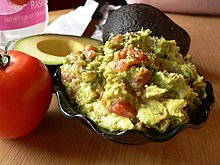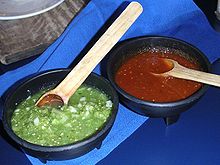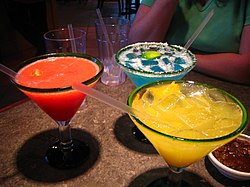Mexican cuisine
This article needs additional citations for verification. (December 2008) |

Mexican cuisine is a style of food that originated in Mexico with a considerable Spanish influence. Mexican cuisine is known for its intense and varied flavors, colorful decoration, and variety of spices.
National cuisine




When conquistadores arrived in the Aztec capital Tenochtitlan (now Mexico City), they found that the people's diet consisted largely of corn-based dishes with chilies and herbs, usually complemented with beans and tomatoes. The conquistadores eventually combined their imported diet of rice, beef, pork, chicken, wine, garlic and onions with the native indigenous foods of pre-Columbian Mexico, including chocolate, maize, tomato, vanilla, avocado, guava, papaya, pineapple, jicama, chile pepper, beans, squash, sweet potato, peanut, fish and turkey.
Corn is its traditional staple grain, but today, rice is equally important. According to food writer Karen Hursh Graber, the initial introduction of rice to Spain from North Africa in the 4th Century led to the Spanish introduction of rice into Mexico at the port of Veracruz in the 1520s. This, Graber says, created one of the earliest instances of the world's greatest fusion cuisines.[1]
In Pueblitos or villages, there are also more exotic dishes, cooked in the Aztec or Mayan style (known as comida prehispánica) with ingredients ranging from iguana to rattlesnake, deer, spider monkey, grasshoppers, ant eggs, and other kinds of insects.
Common dishes in on a national level
Foods that are part of the Mexican culinary tradition include:
- Common appetizers and side dishes found in Mexican cuisine
- Common main course dishes found in Mexican cuisine
- Common drinks found in Mexican cuisine
- Common desserts and sweets found in Mexican cuisine
Regional cuisine

Mexican food varies by region, because of local climate and geography and ethnic differences among the indigenous inhabitants and because these different populations were influenced by the Spaniards in varying degrees. The north of Mexico is known for its beef, goat and ostrich production and meat dishes, in particular the well-known Arrachera cut.
Central Mexico's cuisine is largely made up of influences from the rest of the country, but also has its authentic dishes, such as barbacoa, pozole, menudo and carnitas.
Southeastern Mexico, on the other hand, is known for its spicy vegetable and chicken-based dishes. The cuisine of Southeastern Mexico also has quite a bit of Caribbean influence, given its geographical location. Seafood is commonly prepared in the states that border the Pacific Ocean or the Gulf of Mexico, the latter having a famous reputation for its fish dishes, a la veracruzana.
In modern times, other cuisines of the world have become very popular in Mexico, thus adopting a Mexican fusion. For example, sushi in Mexico is often made with a variety of sauces based on mango or tamarind, and very often served with serrano-chili blended soy sauce, or made with habanero and chipotle peppers.
Mexican cuisine outside of Mexico

A distinction must be made between truly authentic Mexican food, and "Tex Mex" (Texan-Mexican) cuisine. Mexican cuisine combines with the cuisine of the southwest United States (which itself has a number of Mexican influences) to form Cal-Mex and Tex-Mex cuisine.[citation needed]
The six regions of Mexico differ greatly in terms of cuisine-style; it is almost as if each region is their own separate country with separate cuisines. In the Yucatan, for instance, a unique, natural sweetness (instead of spiciness) exists in the widely used local produce along with an unusual love for achiote seasoning. In contrast, the Oaxacan region is known for their savory tamales and celebratory moles. New Mexican and Southern Arizonan cooking differ from Northern Mexican cuisine far less than, for example, Mexico City cuisine and California-style Mexican cuisine differ from Northern Mexican.[citation needed]
While Mexican Restaurants can be found in almost any town throughout the United States, and in many cities around the world, restaurants outside the American Southwest often feature nontraditional ingredients, such as grated American-style cheese, "nacho" cheese or tomato-based sauce substitutes for Mexican chile-based sauces or mole.

Texas, New Mexico, Arizona, California, and parts of Florida and Illinois have large expatriate Mexican populations, and a variety of authentic Mexican restaurants can be found in these states. In other areas of the United States and Canada, Mexican dishes and restaurants vary as much as Italian restaurants and dishes do between Italy and many locations in the western Hemisphere.
New Mexico's long tradition of Mexican settlement and history and native American influence as well, has created a distinct form of New Mexican cuisine. Even though many of the dishes vary from their Mexican counterparts, they are still considered "authentic" or "traditional" for New Mexican cuisine. Both Mexicans and New Mexicans typically find each other's cuisine very similar, yet unfamiliar, and non-traditional, typically missing the true taste that they desire. Rarely are Mexican restaurants specializing in New Mexican cuisine found outside of New Mexico (even in Arizona) except in very large cities.
See also
References
- ^ Hursh Graber, Diana. "Rice, the Gift of the Other Gods" 2003.

